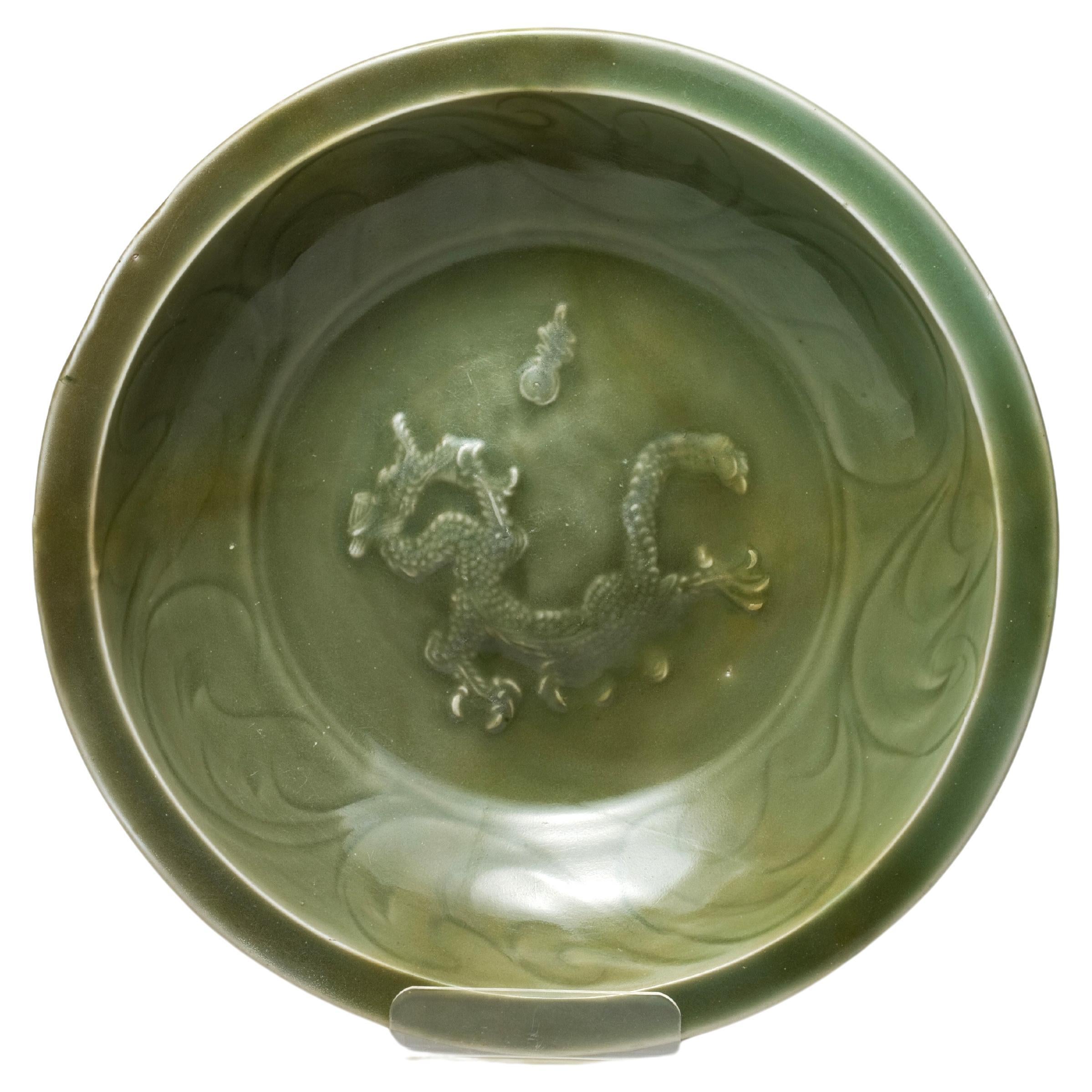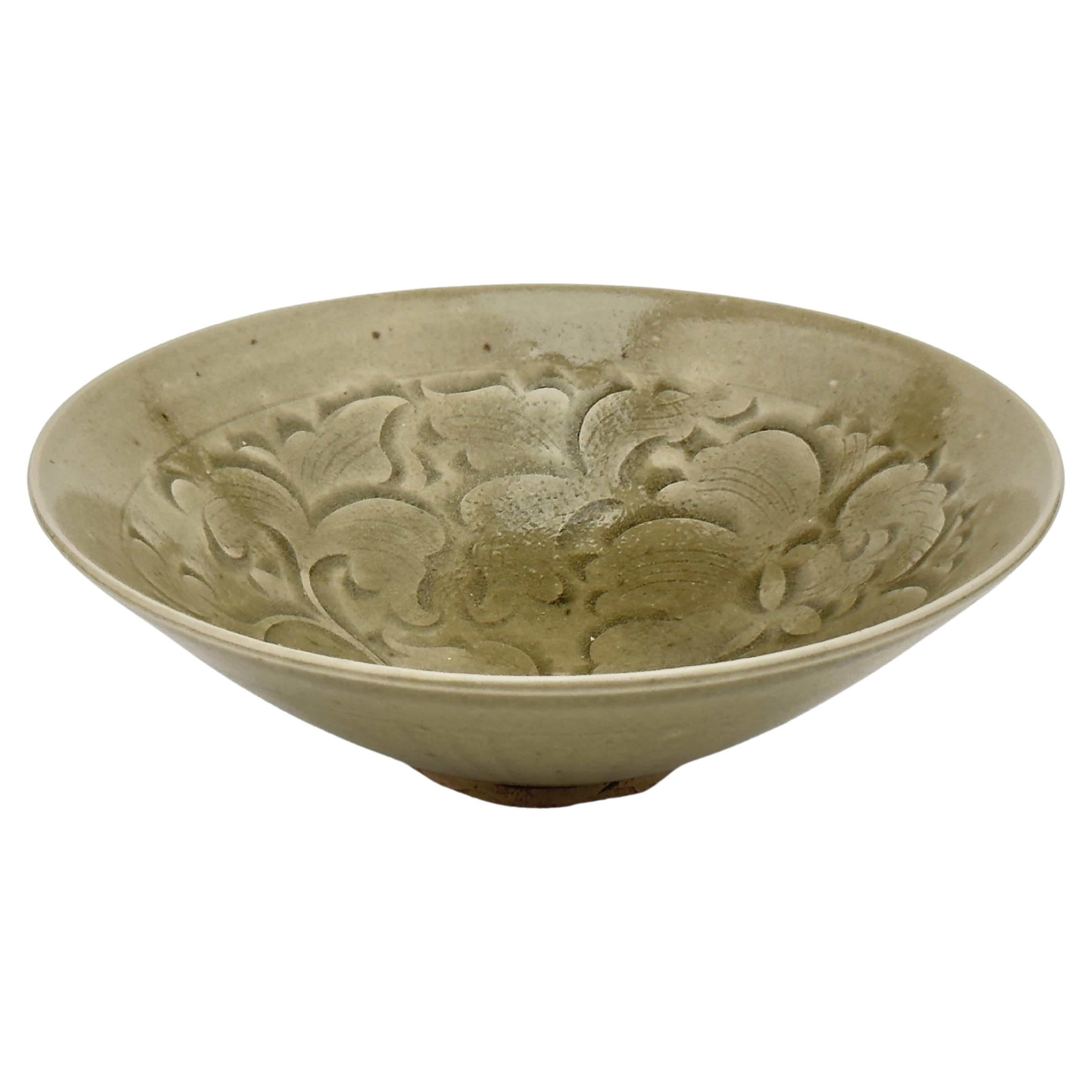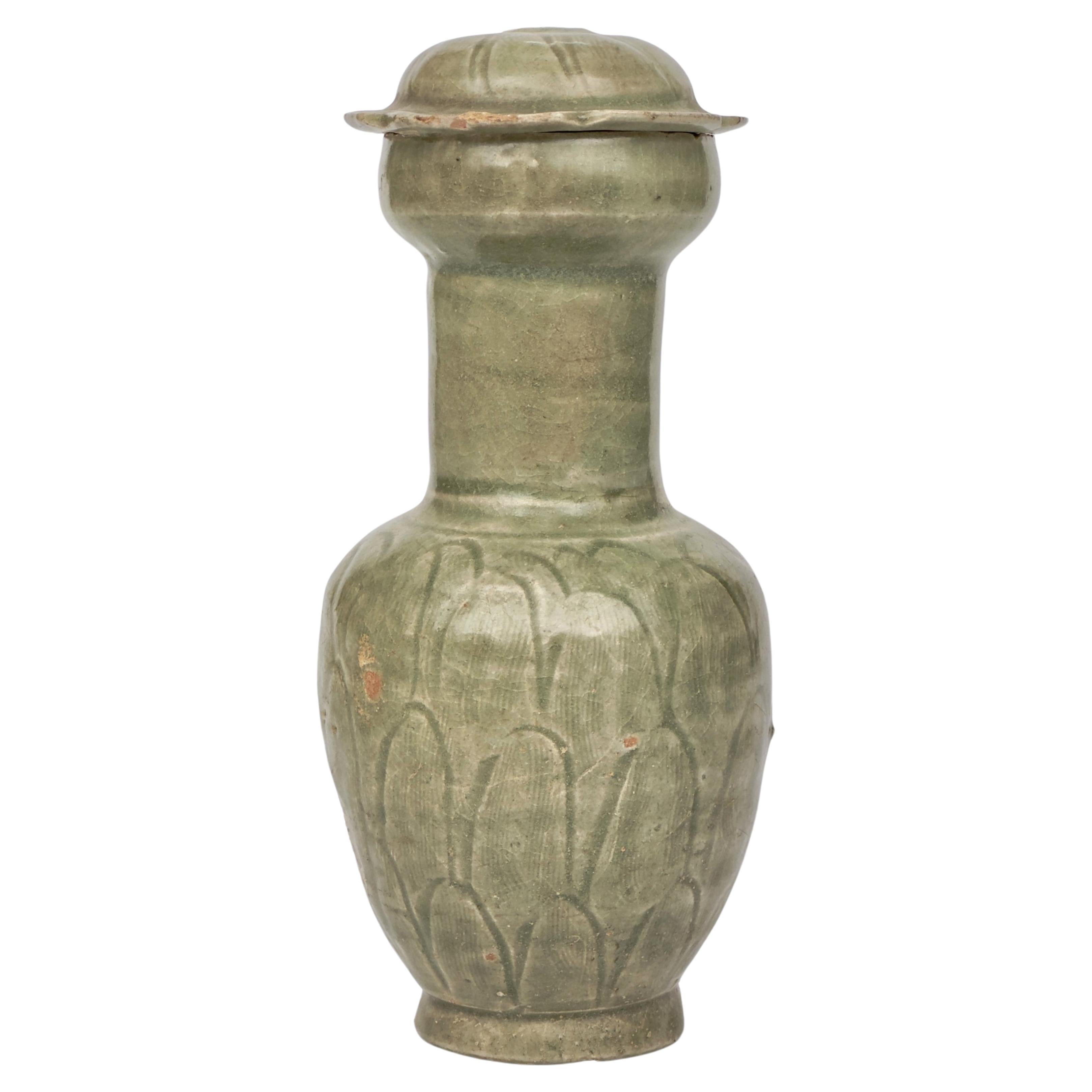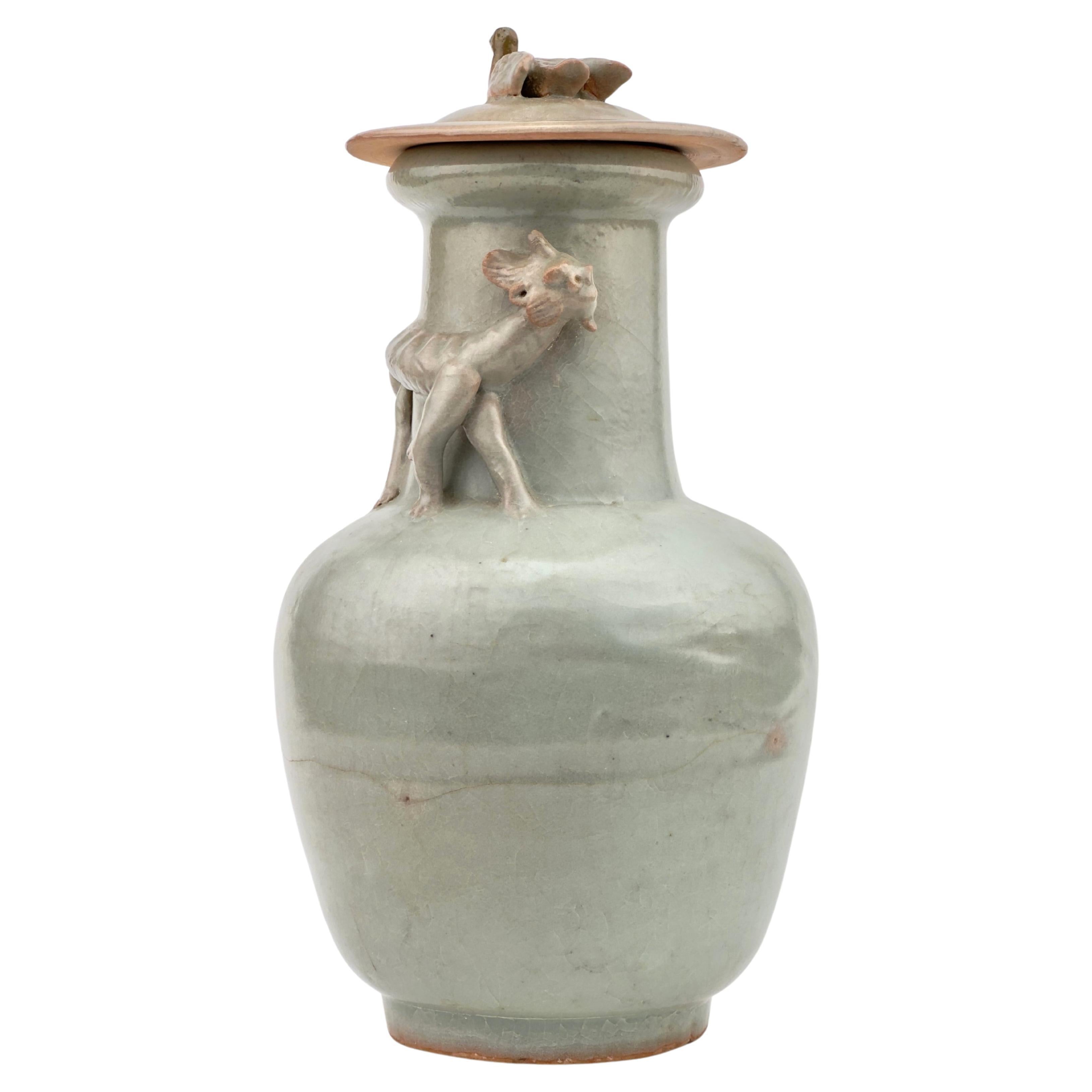Items Similar to Carved 'Longquan' Celadon-glazed Funerary vase and cover, Song dynasty
Want more images or videos?
Request additional images or videos from the seller
1 of 16
Carved 'Longquan' Celadon-glazed Funerary vase and cover, Song dynasty
About the Item
The vase features a ribbed body, subtly enhancing its graceful contours, and is topped with a uniquely sculpted lid adorned with figurative elements.
Period : Song Dynasty
Type : Celadon
Medium : Longquan ware
Size : 26cm(Height) x 7.5cm(Mouth Diameter)
Condition : Good (Chips and traces of oxidation on the lid and parts of the body)
Provenance : Acquired in late 1990s from Hongkong
Reference :
1) LACMA - Lidded Funerary Urn (Hu) with Bird, Dogs, and Lotus Scrolls
(Type : Related)
2) Hongkong 30 NOV 2016 - Important Chinese Ceramics and Works of Art - Lot 3389
(Price : HKD 625,000 / Type : Related)
3) Christies Newyork 23–24 MAR 2023 - Important Chinese Ceramics and Works of Art
(Price Range : USD 18,000 – USD 25,000 / Type : Related)
* Song Dynasty Longquan Celadon
Longquan celadon refers to a type of Chinese ceramic that was famous for its distinctive glaze and high-quality craftsmanship, primarily produced during the Song Dynasty (960–1279 AD). These ceramics were made in the Longquan region of the Zhejiang province in eastern China, an area rich in the clay and mineral resources necessary for ceramic production.
The most notable characteristic of Longquan celadon is its glaze, which ranges in color from a pale blue-green to a deep olive green. This unique color comes from the iron oxide in the glaze, which, when fired in a reducing kiln atmosphere, produces the green hue. The thickness of the glaze, as well as the firing conditions, could affect the final shade and appearance of the celadon, with some pieces exhibiting a more crackled texture and others a smoother, glossier finish.
Longquan celadons were highly prized for their beauty and durability, making them popular both domestically within China and internationally. They were exported widely, reaching as far as Southeast Asia, the Middle East, and Africa, where they were often considered luxury items and treasured by various cultures.
The designs of Longquan celadon wares varied from simple and elegant forms to more elaborate decorations, including carved or incised motifs inspired by nature, such as lotus flowers, phoenixes, dragons, and foliage. Despite the variations in decoration, the emphasis was always on the harmony between form, glaze, and decoration, with the glaze playing a crucial role in enhancing the overall aesthetic appeal of the piece.
During the Song Dynasty, Longquan celadon was one of several major types of ceramics produced in China, each with its own distinctive characteristics. However, the quality and beauty of Longquan celadon made it one of the era's most celebrated ceramic types, and it continues to be highly valued by collectors and scholars today.
- Dimensions:Height: 10.24 in (26 cm)Diameter: 2.96 in (7.5 cm)
- Style:Ming (Of the Period)
- Materials and Techniques:Celadon,Glazed
- Place of Origin:
- Period:
- Date of Manufacture:10-12th century
- Condition:Minor losses. Minor fading. Minor chips and traces of oxidation on the lid and parts of the body.
- Seller Location:seoul, KR
- Reference Number:1stDibs: LU9577239566002
About the Seller
New to 1stDibs
Joined in the past six months.
4.5
Vetted Seller
These experienced sellers undergo a comprehensive evaluation by our team of in-house experts.
Established in 1999
1stDibs seller since 2023
Typical response time: <1 hour
- ShippingRetrieving quote...Ships From: seoul, Korea South
- Return PolicyA return for this item may be initiated within 10 days of delivery.
Auctions on 1stDibs
Our timed auctions are an opportunity to bid on extraordinary design. We do not charge a Buyer's Premium and shipping is facilitated by 1stDibs and/or the seller. Plus, all auction purchases are covered by our comprehensive Buyer Protection. Learn More
More From This SellerView All
- Longquan Celadon 'Dragon' Jar and Cover, Song Dynasty(1127–1279)Located in seoul, KRA similar jar with a cover, part of the Avery Brundage collection at the Asian Art Museum in San Francisco, is featured in Mary Tregear's "Song Ceramics" (London, 1982, plate 286). T...Category
Antique 15th Century and Earlier Chinese Ming Antiquities
MaterialsCeladon
- Longquan Celadon 'Lotus Petal' Jar And Cover, Northern Song Dynasty)Located in seoul, KRThe jar is sturdily potted with an oval shaped body carved with overlapping lotus petals below the straight neck. All covered with a crackled glaze of olive-green color with the exce...Category
Antique 15th Century and Earlier Chinese Ming Antiquities
MaterialsCeladon
- Carved 'Longquan' Celadon-Glazed Tripod Censer, Ming dynastyLocated in seoul, KRThis censer is characterized by its tripod form, which means it stands on three feet. Incense burners from the Ming dynasty are often highly regarded for their craftsmanship and the quality of the glaze texture and coloration. This piece features finely carved patterns that likely draw inspiration from traditional Chinese motifs. Such items were commonly used for burning incense and sometimes served as significant decorative pieces in ceremonial spaces or the homes of the elite. Period: Ming Dynasty (1368~1644) Region: Longquan, China Medium: Stoneware - Celadon glazed Type: Tripod censer Size : 24.2 cm(Diameter) , 10.8cm(Height) Provenance : Acquired in 1999, Hongkong Reference : Sotheby's Newyork 26 September 2023 - CHINA / 5000 YEARS - Lot1135 * Ming Dynasty Longquan Celadon Longquan celadon from the Ming Dynasty typically exhibits a more robust and heavier stoneware body compared to its Song Dynasty predecessors. The Ming era saw an evolution in celadon glaze, achieving a wider spectrum of green hues, from olive to bluish-greens. Ming celadons...Category
Antique 15th Century and Earlier Chinese Ming Antiquities
MaterialsCeladon
- Carved 'Yaozhou' Celadon-Glazed Bowl, Song DynastyLocated in seoul, KRThe bowl is potted with steep, flared sides and decorated to the interior with stylized peonies among scrolling tendrils. The exterior is carved with vertical lines below the everted...Category
Antique 15th Century and Earlier Chinese Ming Antiquities
MaterialsCeladon
- A Longquan Celadon-Glazed 'Dragon' Dish, Yuan DynastyLocated in seoul, KRThe dish is decorated to the centre with a moulded appliqué dragon chasing the flaming pearl surrounded by a carved stylised foliage band at the cavetto. The moulded fluted exterior ...Category
Antique 15th Century and Earlier Chinese Ming Antiquities
MaterialsCeladon
- Longquan Celadon Five-Spouted Jar, Northern Song Dynasty (AD 960~1127)Located in seoul, KRThickly potted with an ovoid body of five horizontal lobes tapering toward the top, carries both aesthetic and practical values. The jar is intricately carved with rows of upright lo...Category
Antique 15th Century and Earlier Chinese Ming Antiquities
MaterialsCeladon
You May Also Like
- Chinese Song Dynasty Green Glazed Buddhist Funerary Jar and Cover - TL TestedLocated in London, GBA vibrant Song Dynasty funerary urn that captures the short-lived, yet fruitful period of Song dynasty artistic production. The body is globular ...Category
Antique 15th Century and Earlier Antiquities
MaterialsTerracotta
- Ming Dynasty Longquan Celadon Glazed ChargerLocated in Stamford, CTLongquan celadon glazed charger having fluted rim with well centre and incised stylized decoration. Ming dynasty. Underside with burnt orange firing m...Category
Antique 16th Century Chinese Ming Ceramics
MaterialsCeramic
- Chinese Song Period Celadon Glazed BowlLocated in London, GBA Chinese Song period celadon glazed bowl. Really nicely thinly potted example with craquelure due to age. Provenance: From a private London coll...Category
Antique 15th Century and Earlier Chinese Archaistic Antiquities
MaterialsPottery
- Chinese Longquan Celadon Ming Dynasty Porcelain VaseLocated in Bradenton, FLChinese Longquan Celadon Ming Dynasty Porcelain Vase. Chinese antique Ming Dynasty celadon porcelain vase with leaf motif. Overall crackle glaze.Category
Antique 17th Century Chinese Ming Ceramics
MaterialsPorcelain
- Impressive Terracotta Funerary Procession - Ming Dynasty, China '1368-1644 AD'Located in San Pedro Garza Garcia, Nuevo LeonImpressive Funeral Ensamble of 10 Terracotta Glazed Figures in green and caramel colors depicting a votive procession with a palanquin, his four carriers, a horse, a stableman, two musicians, and an offering carrier. This ensemble is accompanied by a Certificate of Authenticity, and Certificate of Expertise by Jean-Yves Nathan - Specialist in Asian Arts for the CEDEA (The European Confederation of Art Experts). Burial figurines of graceful dancers, mystical beasts, and everyday objects reveal both how people in early China approached death and how they lived. Since people viewed the afterlife as an extension of worldly life, these figurines, called mingqi, sometimes referred as “spirit utensils” or “vessels of ghosts” disclose details of routine existence and provide insights into belief systems over a thousand-year period. The Ming dynasty was the ruling dynasty of China – then known as the Empire of the Great Ming – for 276 years (1368–1644 AD). Founded by Chu Yuan-chang, the rebel leader that was successful in removing the mongols from the throne. Chinese control was re-asserted in China and eastern Asia. Literature became more important, schools were created, and the justice system was reformed. The Ming dynasty is described by some as "one of the greatest eras of orderly government and social stability in human history,” was the last imperial dynasty in China ruled by ethnic Han Chinese. The practice of burying ceramic objects with the deceased went into decline from the 10th to the 14th Century AD. There was a revival in placing miniature representations of glazed terracotta objects such a furniture, food offerings, horses, miniature statues...Category
Antique 15th Century and Earlier Chinese Ming Antiquities
MaterialsTerracotta
- Han Dynasty Green Glazed Covered Storage JarLocated in Austin, TXA wonderful Han Dyansty (206 BC-200 AD) storage vessel. The circular body set upon three legs and fitted with a lid. The entirety covered in heavy leaded green glaze, imitating bronz...Category
Antique 15th Century and Earlier Chinese Han Antiquities
MaterialsPottery





